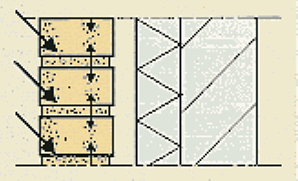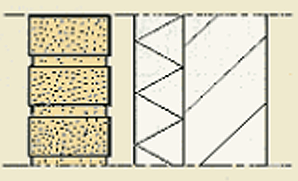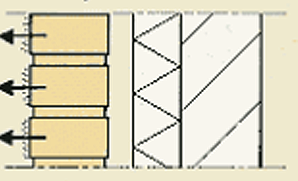Protective measures are often not taken due to the pressures of tight construction schedules and the high speed of building required. Under unfavourable weather conditions, the bonding process in the brick mortar is poor, and soluble substances can remain in the bricks and/or joint mortar. During the normal drying process, these usually bond smoothly. Substances present in the brick can also lead to erosion as a result of excessive rainfall.
In both spring and autumn, after a few dry, sunny days, preceded by a prolonged wet period, substances that have not yet bonded, are transported to the brick surface by capillary water action.
After the water has evaporated, a white film is left on the fresh masonry (see images below).
Treatment of this residue on bricks can be done in several ways. White erosion almost always occurs on masonry that has been exposed to excessive (rain) water and then dries. Excessive moisture on the fresh masonry dissolves free lime and residual sulphates from the brick, which crystallise on the surface when dry. Depending on the intensity of the treatment, the sulphate residue is removed by rinsing it with rainwater after a few months to a few years. During this period, the staining can recur several times. For a quick removal in order to deliver clean bricks, the best approach is to brush off the residue first, preferably dry (do not use a steel brush). The remaining residue can then be removed with water. If necessary, repeat the treatment should the staining recur.
If limestone (calcium carbonate) is present, cleaning is necessary. This residue is caused by the carbonation of dissolved calcium compounds on the brick surface. Suitable products based on sulphamic acid are available for cleaning. Always follow the manufacturer's instructions. The use of products containing hydrochloric acid and phosphoric acid is strongly discouraged.
Info from KNB https://www.knb-keramiek.nl/themas/gevelbaksteen/publicaties/infobladen/

F.ig.1 Efflorescence
When carrying out work, the masonry absorbs water from the mortar and from the rain. Soluble substances are mainly found in the mortar.

Fig. 2. Efflorescence
Water dissolves the substances and transports them through the masonry.

Fig. 3 Efflorescence
Water evaporates and the substances become visible on the surface as efflorescence.
Do you have any other questions about efflorescence?
Please don't hesitate to contact us. We are happy to help.
Contact us